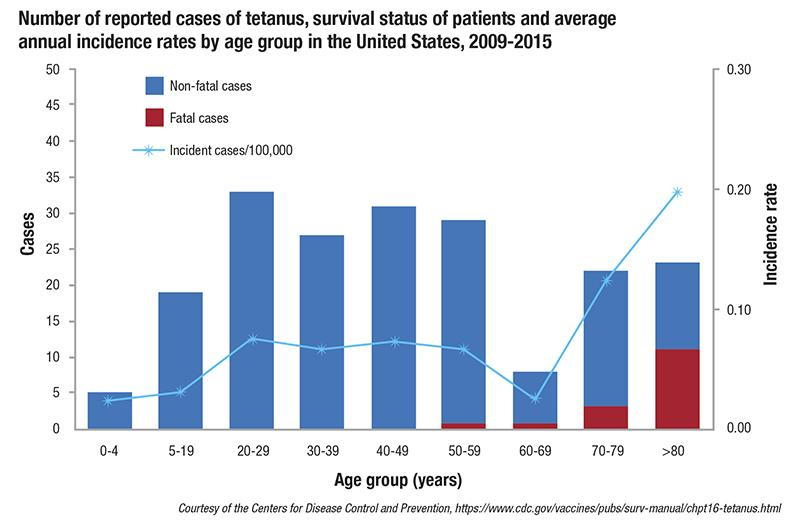Tetanus spores lie in wait for unvaccinated children
- Guzman-Cottrill JA, et al. “Notes from the Field: Tetanus in an Unvaccinated Child - Oregon, 2017.” https://www.cdc.gov/mmwr/volumes/68/wr/mm6809a3.htm.
Tetanus is caused by a neurotoxin called tetanospasmin produced by the anaerobic, spore-forming, gram-positive bacillus Clostridium tetani. Tetanospasmin affects the nerve endings at the nerve-muscle junction, leading to severe skeletal muscle spasms and convulsions.
The dormant spores are everywhere in soil and intestinal tracts of mammals and can survive for months to years. The spores germinate and begin to produce the neurotoxin under favorable conditions, which include contaminated wounds due to traumatic injury, deep puncture wounds caused by dirty nails or animal bites, inappropriate umbilical cord care in the neonate or a foreign body in the skin.
Pediatric tetanus case
In 2017, an unvaccinated 6-year-old boy developed tetanus following a forehead cut he sustained while playing outdoors on a farm. It was the first pediatric tetanus case reported in more than 30 years in Oregon.
The patient had jaw spasms and involuntary arm muscle spasms and subsequently developed body stiffness and difficulty breathing due to diaphragm and voice box spasms.
He was air-transported to a pediatric medical center where he received intensive care, including sedation, analgesia, endotracheal intubation (followed by tracheostomy), mechanical ventilation and neuromuscular blockage in an environment with minimal stimulation (a darkened room and ear plugs). He also developed nervous system (hypertension, tachycardia and body temperature instability).
Antibiotics, tetanus immune globulin and diphtheria and tetanus toxoids and acellular pertussis vaccine (DTaP) were administered. The wound was irrigated and debrided. He required approximately eight weeks of inpatient care (including six weeks of intensive care), followed by one month of rehabilitation before he fully recovered. The inpatient charges were $811,929.
Although physicians discussed the risks and benefits of tetanus vaccination with his parents, they declined any recommended immunizations, including the second dose of DTaP.
Tetanus worldwide
Although the tetanus toxoid vaccination has contributed significantly to dramatic reduction of the incidence of tetanus, the disease remains a public health problem worldwide. The World Health Organization (WHO) reported that approximately 34,000 newborns died worldwide from neonatal tetanus in 2015, while 86% of infants worldwide were vaccinated with three doses of diphtheria-tetanus-pertussis (DTP) vaccine in 2016.
According to Centers for Disease Control and Prevention (CDC) surveillance, 197 cases and 16 deaths from tetanus were reported in the United States from 2009-’15. While most cases were adults and all tetanus-related deaths occurred in elderly adults, 24 (12%) cases were in patients younger than 20 years of age, including two cases of neonatal tetanus (see figure).

Based on National Immunization Surveys, estimated DTaP vaccination coverage with at least three doses among U.S. children ages 19-35 months was 94% in 2017, whereas coverage with at least four doses was as low as 83%. Importantly, the coverage among uninsured children 19-35 months of age was significantly lower (78% with at least three doses and 62% with at least four doses, which is below the average worldwide) than insured children.
It is crucial to inform caregivers that uninsured or underinsured eligible children can receive vaccines at no cost through the Vaccines for Children (VFC) program (https://www.cdc.gov/vaccines/programs/vfc/index.html).
Tetanus vaccination and safety
One of the striking facts about tetanus is that people cannot naturally acquire immunity to tetanus even after recovery from tetanus disease. This is likely because people can develop tetanus from a small amount of toxin production, which usually is not sufficient to elicit an immune response. In addition, there is no herd protection against tetanus since this is not a communicable disease. Therefore, tetanus vaccination of each child is the only way to provide protective tetanus immunity.
The Recommended Child and Adolescent Immunization Schedule calls for children to receive a five-dose series of DTaP at 2, 4, 6 and 15-18 months and 4-6 years of age. Adolescents should receive a single dose of Tdap at 11-12 years of age.
In addition, adults should receive a Td booster every 10 years, and pregnant women should receive a single dose of Tdap during every pregnancy, preferably during the early part of gestational weeks 27-36.
Information on use of Tdap or Td as tetanus prophylaxis in wound management is available at www.cdc.gov/mmwr/volumes/67/rr/rr6702a1.htm.
Tetanus toxoid-containing vaccines are highly effective and safe. Mild local reactions or fevers are commonly seen, but severe reactions including neurologic or anaphylactic reactions are rare.
Rise of vaccine hesitancy
Vaccine hesitancy and refusal are growing rapidly and are considered one of the major threats to global health by the WHO. Most cases of tetanus in the United States occur in unvaccinated people.
Since vaccine-preventable diseases (VPDs) are uncommon, it is important for health care professionals and the public to be reminded of how devastating VPDs are and that vaccinations are the best way to prevent them. Infants and children are susceptible to all diseases in the immunization schedule if not properly immunized.
Dr. Kamidani is a pediatric infectious diseases fellow at Emory University School of Medicine. Dr. Pickering is adjunct professor of pediatrics at Emory University School of Medicine.
